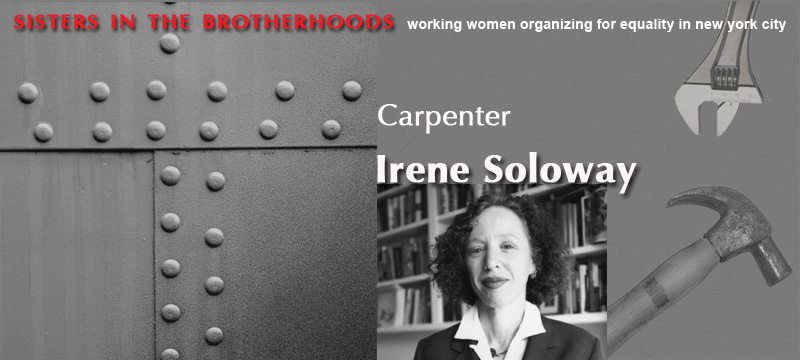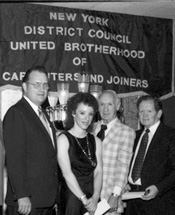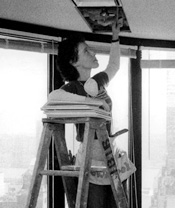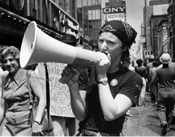 |
|||||||
|
|||||||
|
Irene Soloway joined the carpenters' union in 1979. Together with Consuelo Reyes, she began the tradition of activism among New York City tradeswomen. Soloway was a member of a core group that founded and provided leadership for United Tradeswomen (UT)
In October 1980 UT began a campaign to establish an official women's committee within the New York City District Council of Carpenters (NYDCC). Soloway was among the organizers who wrote a letter to Charles Fanning, head of the district council, inviting him to meet with small delegation of UT women. He did not accept the invitation. In February 1981 an estimated 1,800 women and men waited in line outside the carpenters' labor school to pick up apprenticeship applications. Their long vigil turned ugly when a group of men began taunting the women, and then a stampede ensued when the school's doors finally opened. Fanning and other leaders watched the melee but did not intervene. Soloway and Reyes wrote Fanning a letter offering suggestions for measures that could prevent future problems at recruitment events. Despite the union's unresponsiveness, Soloway and other UT activists continued to pitch their ideas to the union leadership, but to no avail. Working outside union channels, they nevertheless found various ways to support women carpenters. Soloway helped produce the rank-and-file newspaper Hard Hat News and used a number of clever pseudonyms, such as Brick Shields, to disguise her identity. She worked with other civil service carpenters in a long but ultimately successful campaign to get their own union representation within the district council. In April 1990 Soloway and other carpenters, female and male, appeared before the New York City Commission on Human Rights to testify about gender and race relations in the NYDCC. Writing as "Brick Shields" in Hard Hat News (summer 1990), Soloway reported that many female witnesses described the forms of sexual harassment they experienced on the job: rape threats, pornography, graffiti (often personalized), and direct physical threats. During the mid-1980s she was hired by New York City's Health and Hospitals Corporation. Asbestos was a source of contention for Soloway, who was concerned about health and safety practices on the job. Her leadership on this issue led to her election as shop steward. In that position she played a major role in the campaign to fight for safety standards for tradespeople employed at the city's public hospitals—especially where asbestos was a factor. Soloway also was involved in the long campaign for direct representation on the district council, which led to the first direct elections in 1995. While working as a carpenter at Lincoln Hospital, Soloway took pre-med classes. She then completed a full-time, two-year program to become a physician's assistant. Currently she works in primary care at a methadone clinic, an outpatient facility of Albert Einstein College of Medicine. Soloway's oral history includes many examples of her organizational talents, her dedication to United Tradeswomen, and her efforts on behalf of workers' health and safety. |
||||||
| |||||||
Copyright 2012 Jane LaTour/Talking History Photo of Soloway by Gary Schoichet |
|||||||
 Irene Soloway:
Irene Soloway: 
